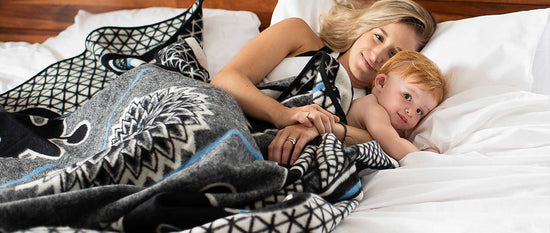
The Ultimate Guide to Choosing the Perfect Blanket Weight for You! (2024)
Share
What's in this article
Your Guide to Choosing the Perfect Blanket Weight that will have you loving life
Weighted blankets are used as a Deep Pressure Stimulation (DPS) therapy to improve sleep quality, among other health benefits.

People are social creatures and respond positively to certain types of touch, like casual hugs or perhaps a gentle but firm massage. Infants thrive on skin-to-skin time and are often lulled to sleep in their mom’s arms.
Hugs are an expression of caring that offers a sense of security. You may think that hugs are for babies and we grow out of this need for security, but it’s not so.
Included in touch are more clinical therapies like occupational and physical therapies, chiropractic therapies, and the use of weighted blankets.
Touch has great healing properties, and weighted blankets improve the quality of sleep, which is recommended for recovery and the restoration of good health.
The science behind the ultimate blanket weight for optimal sleep quality
Do you toss and turn all night and feel drained in the morning? Weighted blankets are designed to help restore sleep quality. The right blanket weight will make a remarkable difference.
The weight of your blanket can profoundly affect your sleep quality. The key lies in deep touch pressure stimulation (DTPS), which mimics the gentle pressure applied to your body when you are hugged or embraced.
DTPS therapy promotes relaxation, reduces anxiety, and improves overall sleep quality. Using a correctly weighted blanket creates a cocoon-like sensation that lulls you into a deep and restful sleep.

How are weighted blankets made, and who are they intended for?
A weighted blanket is a normal blanket made from different fabric types like cotton, linen, flannel, bamboo, and rayon, but with weight added to the blanket. The added weight or fill is evenly distributed over the blanket and can be in the form of sand, pebbles, microfiber beads, micro glass beads, or grains.
There are two basic types of weighted blankets; knitted and duvet-style blankets. The knitted type uses thicker or more dense yarn, which limits the number of materials needed to create the blanket.
Duvet-style weighted blankets have an inner part of the blanket, which comprises tiny individual sewn-together pockets that contain the fill. The outer part of the blanket is normally soft and comforting, with the weight of the blanket ranging between 7 and 30 pounds.
A weighted blanket should weigh approximately 10% of your body weight for adult use.
The same applies to older children and teenagers, but they can weigh about one or two pounds.
Weighted blankets are not intended for babies and toddlers under two years old due to the high risk of suffocation. Other people at risk are those who have asthma, claustrophobia, sleep apnea, and other raspatory conditions.
Therapy using weighted blankets should only be considered if a medical professional recommends it, as underlying medical conditions and medical history may negatively influence the intended therapy and the user.
Weighted blankets are also called gravity blankets. Research has shown that weighted blankets help the body increase serotonin and melatonin production while decreasing the level of cortisol.
Weighted blankets also activate the parasympathetic nervous system, which helps regulate heart rate, blood pressure, and stress levels.
-
Serotonin is a mood-stabilizing hormone that affects your entire body. It improves communication between your brain and nervous system, giving you better control over sensory issues. Serotonin also improves sleeping, eating,
digestion, and bone health. Too little serotonin will cause depression, whereas too much can lead to excessive nerve cell activity. - Melatonin is a hormone produced in response to darkness. It helps with the timing of your circadian rhythms, which is your 24-hour internal clock that helps regulate sleep. Exposure to light at night can block melatonin production and upset your normal sleep pattern.
- Cortisol is a stress or threat control hormone released by your adrenal glands which also releases adrenalin to cope with a perceived threat.
Cortisol increases glucose in the bloodstream, increasing the amount used by your brain. It also increases the levels of substances required to repair tissue.
Non-essential functions are slowed down, and the immune system response is altered. In addition, your digestive system is suppressed, as well as the reproductive system and growth processes.
Your mood will naturally be affected by a release of cortisol, and remaining in stressful circumstances will prolong the effects of cortisol which by natural standards should be short-lived.
From the three hormones mentioned above, you will already be able to understand the benefit of using a weighted blanket. Here are some conditions that may be alleviated or better managed through weighted blanket therapy:
- Attention Deficit Disorder (ADD).
- Attention Deficit Hyperactivity Disorder (ADHD).
- Autism.
- Stress and distress.
- Depression.
- Insomnia.
- Sensory disorders.
As we all know, stress is a condition that affects most people to varying degrees. Our body’s natural response to stress is to produce cortisol as part of our fight or flight response. With continued stress comes the continued production of cortisol, which can lead to the following:
- Depression.
- Anxiety.
- Insomnia and sleep disruption.
- Weight gain from eating/drinking is the first form of addressing the symptoms of stress.
- Irrational decisions on coping with stress-related issues like the harmful use of alcohol, drugs, and prescription medicine.
Why are weighted blankets not recommended for children under two?
Children under the age of two rely on skin-to-skin time with their mom as it contributes to normal development. Newborns need to be swaddled as it mimics the comfort and security of being in the womb.
Being close to mom or other people is important for normal childhood development; however, the benefits of swaddling cannot be replicated with a weighted blanket for infants that have outgrown swaddling.
Swaddling is a phase that helps babies adapt to their new environment, whereas weighted blankets offer therapy for older children and adults as a coping and management tool to reduce the effects of stress-related symptoms or to better manage conditions like autism.
Infants have fragile respiratory systems, and the weight of a weighted blanket will apply continuous pressure that may result in breathing difficulties and possible suffocation.
Because infants younger than two years old don’t have the mastered motor skills to control their immediate surroundings, especially while asleep, so they cannot kick the blanket off if it becomes unbearable.
Another factor is heat generation. Mothers need to control the amount of heat surrounding their baby, and in warm climates, a weighted blanket can trap heat, causing overheating, which can be fatal for infants if left unchecked.
Choosing the right blanket weight
Selecting the correct blanket weight is crucial to sleeping well. A blanket that is too light may not provide enough pressure to promote relaxation, while a blanket that is too heavy can restrict movement, which results in discomfort.
The key is to find a blanket weight that applies gentle, evenly distributed pressure over your body.

Pros of a Weighted Blanket
- Deep Pressure Stimulation induces a feeling of calmness.
- It provides comfort and a sense of security, the same as swaddling does for infants.
- Eases stress and anxiety while promoting better sleep.
- Calms the nervous system.
- It helps to break the cycle of sleep disorders related to stress and anxiety.
Stress and anxiety cause sleep interruptions, exacerbating the condition into a never-ending loop. Quality sleep as a primary therapy can subdue and control stress and anxiety using weighted blankets to restore normal sleep patterns.

Cons of Weighted Blankets
- It can be life-threatening for children under two years old.
- It will take about a month of use for benefits to become truly noticeable.
- It may trap heat depending on the fabric and fill used.
- They are more expensive than normal blankets.

Factors to consider when selecting blanket weight
There are several factors to consider when determining blanket weight. The ideal weight for a blanket largely depends on your body weight. As a rule, select a blanket around 10% of your body weight.
It is important to understand that weighted blankets are medical devices or tools to treat sleep disorders. Medical guidance is recommended before purchasing or using a weighted blanket.
Individual preferences vary, and you should pay attention to your body’s cues. If a 10% weight feels too heavy or too light, you should seek a sleep therapist’s opinion before making any changes.
Also, consider the size and dimensions of the weighted blanket, as a larger blanket may distribute the weight more evenly and provide improved comfort.
Different Blanket Weights and Their Benefits
Weighted blankets are available in various weights, ranging between 5 and 30 pounds or more. Each weight range offers different benefits. This is why a sleep therapist should first be consulted.
Lighter blankets, around 5-7 pounds, are often preferred by younger or older individuals or those who are sensitive to pressure. These blankets provide a gentle, comforting sensation.
Medium-weight blankets typically weigh between 10 and 15 pounds and are the most common choice for adults. They offer a balance of pressure and comfort, promoting relaxation and sleep.'
Individuals who prefer deep, cocoon-like pressure typically use heavier blankets above 15 pounds. These blankets provide a sense of security and may benefit those with anxiety or sensory issues.
It is essential that you consult with a sleep therapist or occupational therapist as your first port of call. Generally, a blanket that is about 10% of your body weight will be recommended.
The correct information is vital, and you will need to recall your comfort level and how well you sleep with a particular weight in relation to the specific condition you are afflicted with.
The impact of blanket weight on sleep conditions
For individuals with insomnia, a weighted blanket can provide a calming effect that promotes relaxation and uninterrupted sleep. The gentle pressure can help alleviate brain activity, making it easier to fall asleep.
People with restless leg syndrome or other movement disorders may benefit from a weighted blanket, as the added weight can help reduce involuntary movements and promote a more settled sleep.
The wonders of deep pressure stimulation therapy include the use of weighted blankets and, at times, a combination of weighted blankets and medication. Once again, sleep disorders should be evaluated by a medical professional.
Weighted blanket therapy can be viewed as a natural treatment for some sleep disorders.

Weighted blanket care
To ensure the longevity of your weighted blanket, proper care is essential. Most weighted blankets come with specific care instructions that should be followed.
In general, spot cleaning or gently hand washing your weighted blanket is recommended to prevent damage to the internal filling.
If machine washing is necessary, use a gentle cycle and minimal mild detergent only. Bleach or harsh chemicals can cause fabric deterioration and affect weight distribution.
When not in use, store your weighted blanket in a cool, dry place to prevent mold or mildew growth.

In conclusion
Weighted blankets are considered medical devices and can be freely used for night sleep or leisurely daytime naps. Snuggling up on a couch under a weighted blanket for a few hours does wonders for your mood.
To get the full benefits of a weighted blanket, it is best to follow the recommendations of your doctor or medical specialist so you can purchase the correct weight and fabric type for your condition. Your first use may feel uncomfortable until you get used to the weight, which might take a week or so.
Once you have experienced the benefits of a weighted blanket first-hand, you will understand why Deep Pressure Stimulation Therapy is the go-to therapy for stress and other conditions that rob so many of us of the much-needed quality sleep we rely on for good health.


